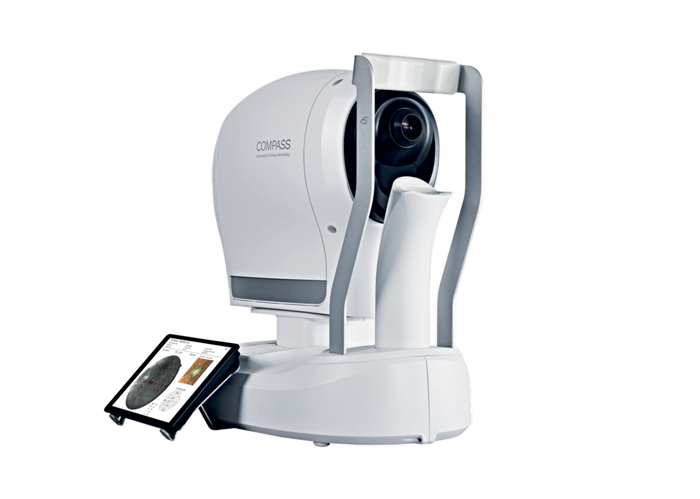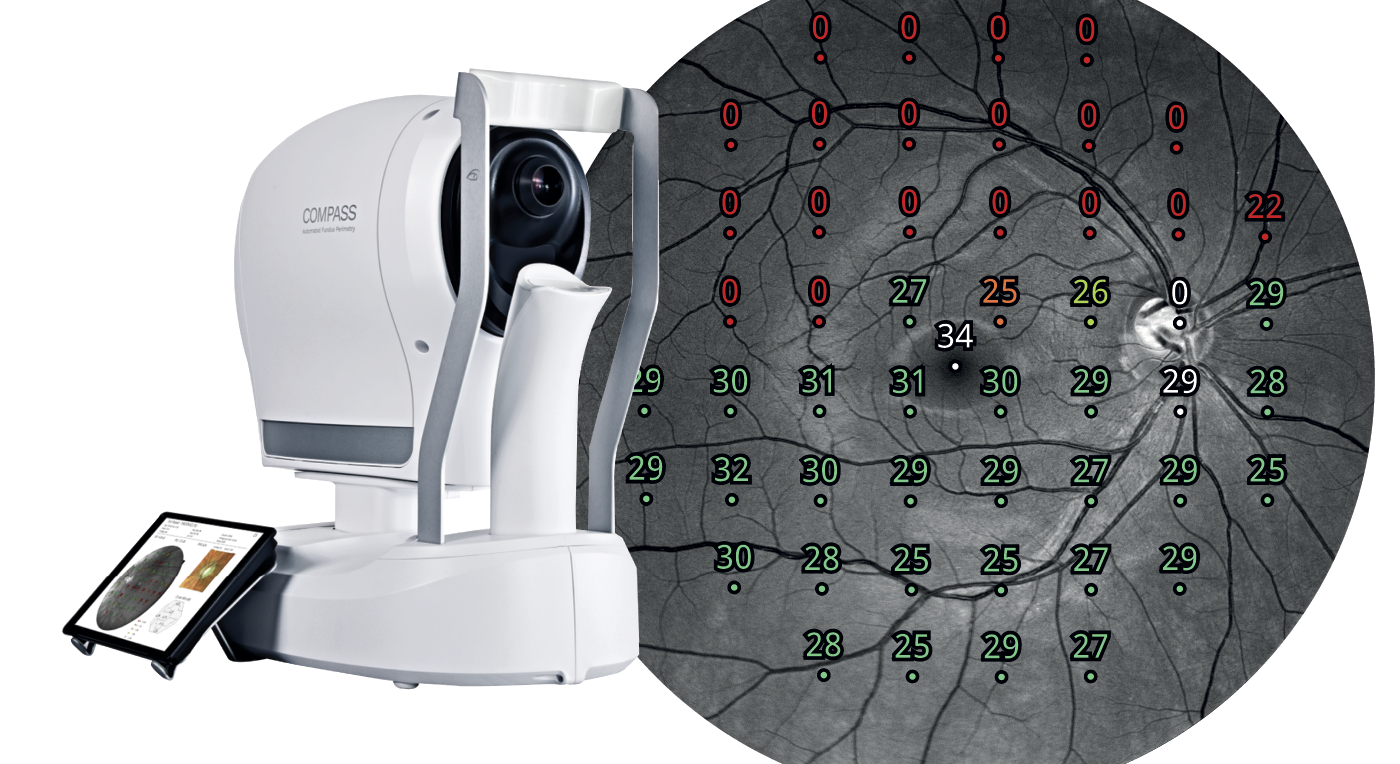
Visual field (VF) deterioration occurs slowly, often taking years before being detected. Eye care professionals need to be able to check and monitor the condition of the visual field at various stages of a disease, as effortlessly and reliably as possible, to ensure optimum patient outcomes.
The iCare COMPASS perimeter answers this need by providing easy, fast, accurate, and repeatable detection of visual field loss (1). The device enables clinicians to seamlessly differentiate between healthy and defective regions of the retina, regardless of whether a disease – such as glaucoma – is in its early, intermediate, or advanced stages. These benefits are much a result of the unique features of COMPASS that include autofocus (removing the need for a trial lens), as well as the active 25 Hz retinal tracker combined with the TrueColor confocal fundus imaging.
Increasing speed with ZEST Fast
For visual field sensitivity tests, the ability to shorten the test duration is a welcome feature for any eye care professional. Decreased test periods not only save time for both the clinician and patient, but minimize the effects of fatigue on test quality, as well as improving patient comfort throughout the procedure, particularly for older patients or those with pre-existing vision issues.
iCare COMPASS offers the standard visual field sensitivity threshold test grids (24-2, 30-2, and 10-2), and enables these grids to be combined with either the 4-2 staircase, ZEST, or the ZEST Fast strategies, with each unique combination determining test duration time. ZEST Fast is a new threshold strategy proven to reduce test times by up to 30 percent in glaucoma patients and up to 40 percent in individuals with healthy eyes when compared to its predecessor (2).

During the test, ZEST Fast compares the computed possible stimulus intensities for the grid point and the situation on the surrounding grid points to automatically determine whether the final threshold sensitivity value has been reached, if more stimuli should be presented, and, if so, what stimulus intensity should be tested. This innovative capability of ZEST Fast enables part of the stimuli presentations on several grid points to be skipped, meaning that final sensitivity thresholds can be found more rapidly without losing out on test reliability.
Streamlining your workflow
The ZEST Fast strategy represents an innovative time-saving feature of the iCare COMPASS – it makes it easier for the patient to concentrate throughout the test, while also maintaining test quality. These factors are also improved by the in-built active retinal tracker that compensates for fixation losses caused by eye movements as well as allows the patient to blink freely without any data losses after all. And even if a patient’s condition does force them to rest during the test, the iCare COMPASS automatically pauses until the patient is ready to continue, requiring no operator intervention and ensuring that no data is lost during this period.
All of these features, unique to COMPASS, signal positive news for those patients who are elderly, or those with medical conditions preventing them from sitting still for prolonged periods of time, as well as for the operators involved in ensuring the best possible outcome for these patients.
Smarter follow-up analysis
The new Smart Progression Analysis (SPA) is another valuable improvement to iCare COMPASS, enabling follow-up workflows to become more efficient and streamlined.
This new feature shows structural and functional changes over time so that eye care professionals are able to accurately evaluate the significance of changes in the Visual Field, as well as determine disease stage, and make precise pointwise progression assessments and predictions on future Visual Field loss.
Drawing from baseline points and follow-up points from at least five prior examinations in three or more years, SPA creates a one-page report to provide a comprehensive review of all the information needed in a Visual Field follow-up.
“This addition to COMPASS Automated Tracked Perimetry greatly speeds up and assists with the evaluation of followup visual fields,” notes Dr. John Warren, founder of the Warren Eye Care Center. Dr. Warren frequently uses COMPASS, combined with the new SPA software capabilities, in his Wisconsin-based clinic. “It helps a lot identifying single and multievent VF changes,” he says, “while increasing not only efficiency, but also confidence in evaluating VF for change over time.”
The iCare COMPASS looks set to provide a faster and smarter addition to the range of perimeters currently on the market, offering an innovative combination of optimal clinic efficiency for both the patient and practitioner, and potentially revolutionizing the world of Visual Field testing.
References
- G Montesano et al., “A comparison between the Compass fundus perimeter and the Humphrey Field Analyzer,” Ophthalmology, 126, 242 (2019). PMID: 30114416.
- D Romano et al., “Comparison Between 24-2 ZEST and 24-2 ZEST FAST Strategies in Glaucoma and Ocular Hypertension Using a Fundus Perimeter,” J Glaucoma, 3, 162 (2024). PMID: 38245812.
